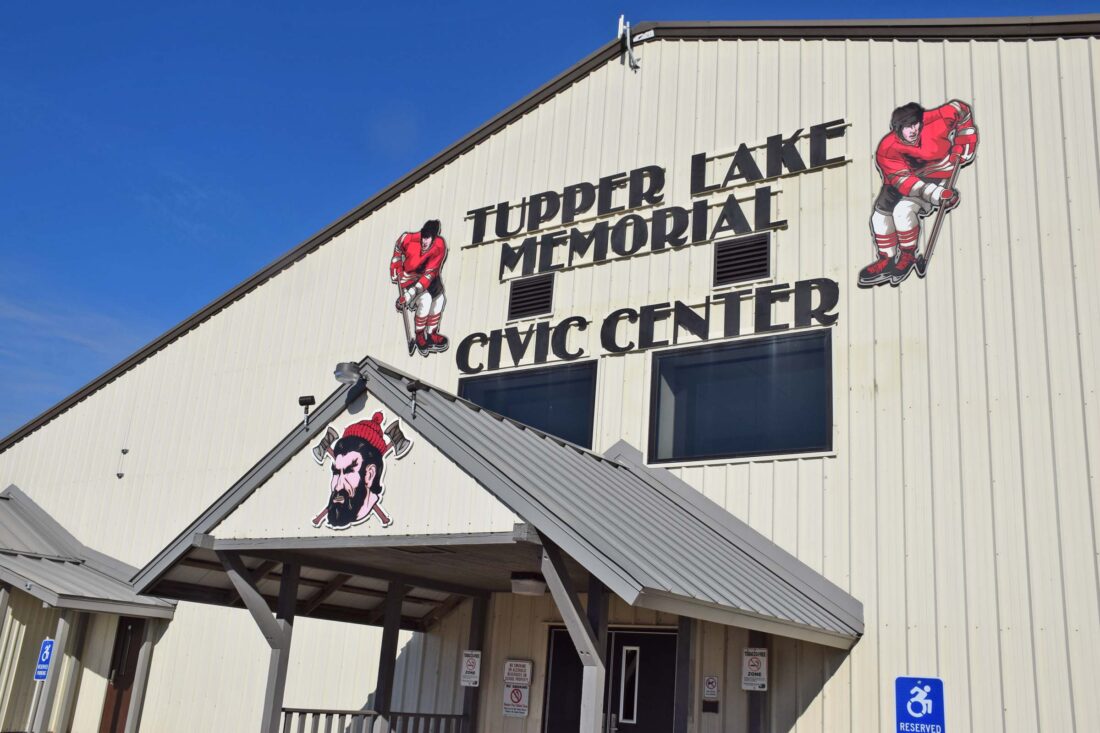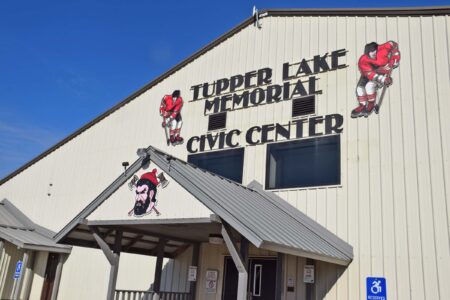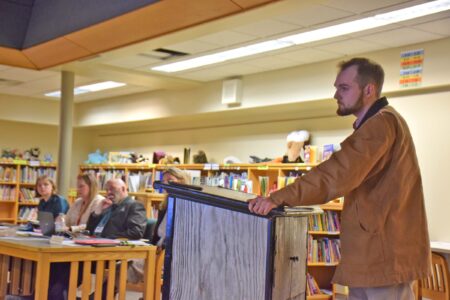Study: TL Civic Center draws 5x economic value than it costs
Economic analysis estimates $716K annual value to community, cites issues with school district ownership
- The Tupper Lake Memorial Civic Center is seen in October 2024. (Enterprise photo — Chris Gaige)
- Saratoga Associates Community Planner Jackson LaSarso presents an economic impact study for the Tupper Lake Memorial Civic Center at the Tupper Lake Central School District’s Board of Education meeting on Monday, Nov. 3. The civic center is owned and operated by TLCSD. (Enterprise photo — Chris Gaige)

The Tupper Lake Memorial Civic Center is seen in October 2024. (Enterprise photo — Chris Gaige)
TUPPER LAKE — Last week, the community learned just how much the Tupper Lake Memorial Civic Center is estimated to be worth.
A study commissioned by the Tupper Lake Central School District and undertaken by Saratoga Associates, an architectural and land planning firm, was presented at the Nov. 3 school board meeting. The study found that the civic center has a total economic impact of $716,622 per year, about five times its annual operating costs. This is different than revenue, which is considerably lower at around $50,000, according to the study, which added that the civic center operates at an annual operating deficit of around $100,000.
TLCSD owns and operates the civic center and received an $11,000 donation to fund the study, which began this spring.
It finds the civic center to be a worthwhile community asset, while noting that some limitations and inefficiencies come with the school district operating it — which the report described as “an uncommon governance model” as compared to peer institutions — suggesting several options for more efficient operation. These include: A district-to-nonprofit long-term building lease, a municipal lease with a nonprofit sublicense or an outright title transfer to municipal ownership.
These recommendations, though, come with a caveat in the report that TLCSD athletics should remain a priority when it comes to scheduling. It recommends that TLCSD issue an RFI or an RFQ to find “a qualified nonprofit or operating partner” and program the space events around, and secondary to, the school athletics calendar.

Saratoga Associates Community Planner Jackson LaSarso presents an economic impact study for the Tupper Lake Memorial Civic Center at the Tupper Lake Central School District’s Board of Education meeting on Monday, Nov. 3. The civic center is owned and operated by TLCSD. (Enterprise photo — Chris Gaige)
The report adds that this partner organization should assume sponsorship sales and event packaging, and share revenue or pay rent under clearly stipulated performance commitments. This arrangement would preserve public access, protect student use, while enhancing the commercial aspects that a school district inherently cannot preform.
“The (school) district runs what is fundamentally a community recreation asset, a role largely outside of its core expertise,” the report states. “The arrangement constrains eligibility for many grant programs, puts an annual operating deficit on the school budget and embeds higher labor and benefit costs than a volunteer or recreation-department model would.”
Marginal staffing costs are considered high here, as every hour of expanded programming carries district wage and benefit rates, according to the report. It added that this current arrangement makes it financially difficult to host additional functions, even if the demand is there. This presents a conundrum.
“Off-season represents the largest growth opportunity,” the report states. “Without programming, the slab sits largely idle for half the year, leaving potential revenue and community benefit untapped. Limited commercial capacity compounds the problem: there is no dedicated structure for sponsorship sales, advertising or event recruitment.”
Just because the school district might not be the best entity, financially or logistically, to operate the civic center, the report is clear that the building is worth maintaining. Closing it would only offer short-term budget relief, while creating long-term costs through negative externalities.
These include more traveling to play on ice and the costs that come with that, reduced physical and mental health benefits from a lack of ice time and reduced economic benefits from visitors no longer coming to Tupper Lake for the ice. These would far exceed how much it costs to operate the Tupper Lake Memorial Civic Center, according to the report.
“The Civic Center is an asset, not a liability,” it states. “Documented benefits extend beyond immediate site revenue. The Civic Center’s use value and consumer surplus avoided travel and time costs when local ice is available, measurable health benefits tied to program participation and visitor spending captured by events all demonstrate a clear, positive effect for the Civic Center.”
The report further notes that the current “operating subsidy” — i.e. the operating deficit that is picked up directly by school district taxpayers, as the district receives no state aid reimbursements on the civic center, given that it’s a non-academic building — reflects small-market scale constraint to revenue, not a failure of the civic center itself.
The report offers several suggestions on how it could be operated to generate higher revenues. These include warm-season operations, such as summer roller skating or portable infill-free turfing for other athletic events during that time, though it notes that this would have to be undertaken prudently to ensure the civic center makes its money back on any turf investment. Other suggestions are for low-capital off-season uses, such as vendor fairs, health and safety clinics and other recreational endeavors, such as indoor yoga classes.
–
How ‘economic impact’ was determined
–
Rather than just looking at revenue, the total economic impact considered four primary areas: user-derived value ($375,915), direct spending ($260,000), health impact ($44,310) and avoided costs ($36,398).
The usage rates that underpinned these figures were largely determined by geolocation information from Cobalt Community Research, which uses anonymized cellphone location data to track how many people were at the civic center in a given time period, though the study did not explicitly mention what timeframe this geolocation data was gathered from.
The study estimates about 50,000 visits annually, with a margin of error of plus or minus 2,500 visits, over 750 hours of building use, or an average of 67 visitors per hour when the civic center is in use. Of those, 56.2% of the visitors were found to be traveling between zero and five miles to use the civic center. Another 12.9% were found to be traveling between six and 30 miles to use the civic center. Another 19.6% were found to be traveling between 30 and 100 miles, 7.9% are traveling between 101 and 250 miles and 3.4% of visitors were found to come from more than 250 miles away.
–
User-derived value
–
The user-derived value is based on the U.S. Army Corps of Engineers Unit Day Value, essentially a measure of how much someone is willing to pay — regardless of what an attraction may or may not charge — for the enjoyment of a certain recreational activity per day. That ranges from $5.17 to $15.52 per person for general recreation in 2025, with the report noting that another estimate from the Ohio State University Recreation Use Values database places the figure at $19.53 per person each day when it comes to playing on a sports team.
Saratoga Associates notes that since the civic center supports a wide array of team events and individual skating, it took a conservative approach in the Unit Day Value calculations, and applied it only to “regular users,” or those traveling less than 30 minutes to get there. The analysts calculated that to be $375,915.
–
Direct spending
–
“Direct spending” is a bit of a misnomer in this context, as it covers not just what people spend at the civic center itself for ice time, but rather the estimated revenue that civic center users bring to the Tupper Lake economy overall — such as going to a local restaurant after an event at the civic center. The spending primarily focuses on out-of-region visitors, or those traveling more than 100 miles to get to the civic center.
Major events hosted by the civic center include Phil Edwards Classic and Empire State Games Sled Hockey, along with the civic center often serving as a neutral site for traveling teams, such as the Massena River Queens versus Glens Falls in 2023. Lodging costs were left out, with Saratoga Associates noting that most out-of-town visitors do not stay overnight when visiting the civic center.
In lieu of civic center trip-specific spending data, Saratoga Associates estimated data based on credit card expenditures reported anonymously in aggregate by the Regional Office of Sustainable Tourism, both for general leisure trips to Franklin County from visitors coming from at least 50 miles away between September 2024 and August 2025 and data from single-day Tinman visits in 2023, 2024 and 2025.
Based on these, inflation-adjusted spending ranged from $321 to $470 per person per day, though these were reduced when the lodging portion of the visit was taken out. The final result was a range of direct spending, from $260,000 to about $600,000. The lower bound reflects 1,700 annual civic center visitors per year, spending about $153 per day, while the upper bound is closer to 4,000 visitors annually, or that more users are staying overnight and spending at hotels.
For this analysis, Saratoga Associates used the lower figure out of an abundance of not wanting to overstate the impact, though it states that it’s “almost certainly more conservative than reality.”
–
Health benefits
–
The report notes that health benefits are “highly significant, albeit harder to quantify.” Essentially, the analysts sought to determine the difference in physical activity, measured as units of energy expenditure, or “metabolic equivalents,” during ice play time from the sedentary metabolic baseline, and looked at the marginal cost to create this activity.
On one hand, the study notes this $44,310 health impact figure is conservative, as it does not take long-term potential medical cost savings into account, nor does it take “nonmarket” benefits, such as a social connection or improved academic performance that’s been demonstrated to generally occur in those getting routine physical exercise.
On the other hand, it notes that the figure may overestimate reality, in that if the civic center were not there, some people getting their physical exercise from it could and would plausibly find another medium for that, such as playing basketball or skiing.
“Even with these caveats, the model provides a key framework for quantifying and valuing the physical benefits of recreation infrastructure,” the report states,
–
Avoided costs
–
This was perhaps the most straightforward category to calculate — largely because the analysts had the 2024 costs that came when hockey teams and skaters who typically used the civic center had to travel to surrounding ice rinks in Saranac Lake and Lake Placid when a chilling vessel failed, resulting in a multi-month shutdown.
The travel had tangible marginal costs of $571 per bus trip, which would have resulted in the district paying $20,160 if expanded to a full 14-week season, plus labor costs of $3,822. This alone is a conservative figure, the report notes. To make the cost more realistic, analysts added “travel time,” basically the cost of wasted time sitting in a bus or car when students, coaches and families could have otherwise been doing other, more productive things.
It is calculated based on 2016 U.S. Department of Transportation guidance for benefit-cost analysis, which the report notes is 50% of hourly median household income, the five-year average of which is about $60,000, according to the report. Therefore, the travel time is $14.61 per hour, and the report notes the average travel time last season, when weighted between Saranac Lake and Lake Placid, was 90 minutes round-trip. This resulted in a figure of about $22 per person, or $920 over the full season. When multiplied by the number of people it affected, the report came up with a total travel time cost of $12,272.68 per season, which is added to the direct travel costs for the full $36,398 “avoided costs” that the repair claims the civic center saves the community.
The report also mentioned some qualitative benefits that could not be accounted for in the financial analysis, but were nonetheless strong reasons to maintain the civic center.
“As one community member put it, it’s refreshing to see ‘children not glued to their phones and parents interacting with them’ at the Civic Center, the report states. “All ‘genuinely having fun and enjoying each other’s company,’ rather than each generation retreating to their own devices.”





